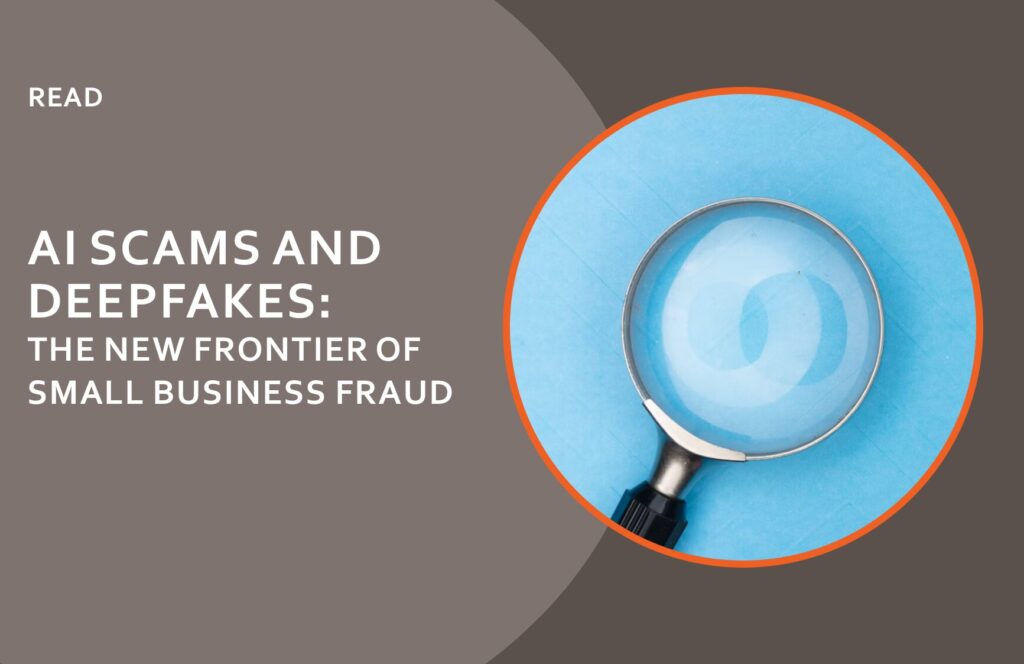READ: AI Scams and Deepfakes: The New Frontier of Small Business Fraud

Fraudsters have upgraded. What used to be opportunistic phishing is morphing into something much more disconcerting: AI-powered scams and deepfakes that impersonate voices, faces, and entire identities. The level of sophistication continues to increase at a breakneck pace. Small organizations often assume those threats are reserved for big enterprises. They aren’t. These attacks are becoming a real risk for smaller organizations.
What Are Deepfakes and AI Scams?
Deepfakes are synthetic or manipulated audio, video, or images created using generative AI. They can convincingly mimic someone’s voice or face. AI scams, more broadly, use automated tools to scale fraud, whether it’s fake websites, chatbots, or voice clones.
How Has AI Enabled “Smart” Fraud?
AI tools make it possible for attackers to:
- Generate emails that read like they’re from your boss or a client.
- Create deepfake videos or audio that mimic executives’ voices.
- Launch hyper-personalized scams at scale, targeting dozens of employees at once.
What used to be a clumsy scam are quickly becoming convincing.
How Do AI Scams Target Small Businesses?
AI is evolving quickly and smaller organizations need to continue to think critically about the data presented to AI applications and work to ensure their entire team is doing the same. Examples of how cyber criminals are using AI to target small businesses are:
- “CEO voice” scams trick staff into transferring money or sharing sensitive data.
- Deepfake invoices appear legitimate, complete with forged voices confirming payment requests.
- AI-powered phishing messages blend in so well that they may bypass traditional filters.
For example, a major engineering firm, Arup, lost $25 million after attackers used a deepfake video impersonating a senior manager to authorize fund transfers. (credit: Financial Times)
For smaller businesses, where staff often juggle multiple roles and don’t have formal approval processes, these scams are particularly dangerous.
How is AI and Fraud Co-Evolving?
Generative AI doesn’t just empower fraud; it also creates a moving target:
- Criminals use prompt injection and AI-based tools to refine phishing messages, reduce errors, and bypass filters.
- Deepfake attacks are blending into other fraud types like identity theft and spoofing. One survey found deepfake fraud is as common now as traditional fraud techniques.
Fraud tools are evolving fast. Your defenses need to keep up.
What is Prompt Injection?
Prompt injection is a type of cyberattack that targets artificial intelligence (AI) systems, especially those that rely on large language models. Instead of hacking software code directly, attackers manipulate the instructions (or “prompts”) given to the AI so it behaves in unintended ways.
Small businesses are adopting AI tools quickly: chatbots for customer service, AI-powered email filters, even bookkeeping and scheduling apps. Prompt injection turns those helpful tools into risks.
-
-
A malicious actor could trick your chatbot into leaking private customer data.
-
An attacker could manipulate your AI-driven invoice processor into approving fake payments.
-
They could use compromised AI tools to spread misinformation in your name.
-
You don’t need a PhD in AI to defend against this. The key is knowing the risk exists, choosing vendors who actively protect against it, and building simple checks and balances into how you use AI.
Takeaway: If your business uses AI tools, prompt injection isn’t an abstract threat—it’s a practical risk worth factoring into your cybersecurity strategy.
What Are Practical Steps Small Businesses Can Take Against AI Scams and Fraud?
Here are steps OrbitalFire recommends that you can take:
- Cultivate skepticism for high-stakes requests
If someone calls, emails, or video-chats asking for money or data, especially unexpectedly, verify through a separate channel (in person, on a known number). - Set policies about verification
Require two-factor validation for money transfers or sensitive decisions. You can enforce “red flags” even without heavy tech. - Train your people on deepfake awareness
Show examples. Teach employees what unusual behavior or mismatch in context might look like. Humans are still vital filters. - Limit exposure from vendors and partners
If someone requests that you change wiring instructions via a video call or email, treat it as suspicious. Confirm through a known source. - Have a response playbook for suspected deepfake fraud
Know who to call: OrbitalFire, your bank, your legal counsel, and have documentation ready to move fast.
Deepfakes and AI scams can magnify your vulnerabilities because they prey on trust, speed, and low scrutiny. But you have options. Understanding how these scams work, training your team, putting in verification controls, and having a response plan give you a fighting chance.
OrbitalFire works with smaller businesses to assess their current cybersecurity strategy and understand their business mission to help them create a Culture of Security that can help fight evolving threats. Learn How Today.





